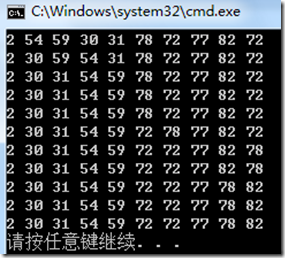1:原理
选择排序是从冒泡排序演化而来的,每一轮比较得出最小的那个值,然后依次和每轮比较的第一个值进行交换。
目的:按从小到大排序。
方法:假设存在数组:72, 54, 59, 30, 31, 78, 2, 77, 82, 72
第一轮依次比较相邻两个元素,将最小的一个元素的索引和值记录下来,然后和第一个元素进行交换。
如上面的数组中,首先比较的是72,54,记录比较小的索引是54的索引1。接着比较54和59,比较小的索引还是1。直到最后得到最小的索引是2的索引6,然后索引6和0互相交换。
第二轮比较的时候是最小的一个元素和索引1进行交换。第三轮、第四轮以此类推。
2:代码
class Program { static List<int> list = new List<int>() { 72, 54, 59, 30, 31, 78, 2, 77, 82, 72 }; static void Main(string[] args) { Choice(); PrintList(); } static void Choice() { int temp = 0; int minIndex = 0; for (int i = 0; i < list.Count; i++) { minIndex = i; for (int j = i; j < list.Count; j++) { //注意这里比较的是list[minIndex] if (list[j] < list[minIndex]) { minIndex = j; } } temp = list[minIndex]; list[minIndex] = list[i]; list[i] = temp; PrintList(); } } private static void PrintList() { foreach (var item in list) { Console.Write(string.Format("{0} ", item)); } Console.WriteLine(); } }
3:输出
4:时间复杂度
O(n^2)
